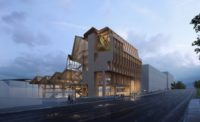Kalamazoo, Michigan
There is a common thread that runs through all of Studio Gang’s work. Each project—whether an 82-story tower, a small open-air pavilion, or the design of a museum exhibition—begins with research into materiality and structure and an emphasis on sustainability; and each results in completely novel and visually striking forms. It is no surprise, then, that the Chicago-based firm led by Jeanne Gang, which has nearly doubled in size over the last couple of years, has taken on those same challenges and aspirations for its latest project. A building without any real precedent, the Arcus Center for Social Justice Leadership creates a new archetype and brings both the pursuit of human rights and a centuries-old, but little-known construction method to the fore.
The site also inspired the one-story structure’s dynamic form. Taking the shape of a pair of boomerangs facing outward and joined together along one wing, its three low, arcing walls culminate in three large rectangular windows facing onto the residential neighborhood to the north, the forested area to the south, and the college’s 20 or so other main buildings downhill to the east. “There’s no secret about what goes on inside,” says design principal Todd Zima. “The openings figuratively and literally engage the community.”
The walls themselves are difficult to decipher. From a distance, their unusual color and texture look almost like a snake’s skin—and, on one side, a snake that has swallowed a very large rodent. That wall, which cantilevers over the sloping ground beneath, bulges at its center to accommodate an eyelet window for a conference room. The opening is an awkward sliver, however, since the walls are so massive. Nearly 2 feet thick, they are composed of 11-inch-long white cedar logs laid crosswise, in a building technique known as cordwood masonry (RECORD, July 2014, page 134), and backed by an air cavity, insulation, and a traditional stud wall. Windows are handled more gracefully on the rest of the wall and the facade to the west—their small, metal-trimmed, circular openings are crisp highlights among the similarly sized log faces. Though the Y-shaped form results in a building with no obvious back or front, the wall that frames the main entrance is the least successful, making it look instead like a service entry. Kept close to the ground, to echo the residential scale of the area it faces, and punctured only with standard entry doors, it is actually too low, dwarfed by the stately homes around it.
The building’s less than grand appearance may also have something to do with the choice of construction. Cordwood masonry is low-tech, cost-effective, environmentally sound, and it provides good thermal value, but it lacks the refinement of traditional masonry. Though there are a few examples of its use in larger houses, including one for Willie Nelson, it is popular among back-to-nature, do-it-yourselfers to build small guest houses, barns, and outdoor saunas. The technique is similar to that for constructing a brick wall. But while a typical brick wall features less than 20 percent mortar, Arcus’s walls feature up to 40 percent, with mortar joints as wide as 4 inches in many spots—an inevitable outcome, given the irregularity of the logs, whose diameters range from 4 to 14 inches. That much exposed mortar makes cracks and gaps created by log shrinkage more visible. When you take DIY construction and elevate it to the level of architecture with a capital A, those aesthetic and technical flaws cannot be overlooked.
The interior is less hippie chic and more 60s Mod, and the contrast is a bit jarring. All curves and no right angles, the nexus of the 10,000-square-foot open space—which includes a central kitchen, several offices, cozy nooks, and all-gender bathrooms that required city approval—is a sunken seating area with a fireplace. The building’s unique program, to support the act of convening in different configurations, “begged us to explore buildings we don’t tend to talk about in architectural history courses,” explains Gang. Inspired by Shaker meeting houses, Indian stepwells, and Native American and Oceanic structures, the non-hierarchical interior, accented by earthy colors, accommodates intimate classes and workshops as easily as large conferences attended by hundreds. Though ceilings are as high as 18 feet and feature expansive clerestories, there is a domestic feel to the space. And while the tricky topography was handled masterfully by creating fully accessible ramps for informal amphitheaters, both outdoors and inside, the strong horizontality of the plan gives the building a Prairie-style quality generally associated with flatter Midwestern landscapes.
Studio Gang’s biggest achievement at Arcus was crafting a truly welcoming space. Despite the shortcomings of the facade, the building’s openness and grass-roots quality, coupled with the warm interiors, speak loudly to the center’s mission of creating a more just and inclusive world.
People
Owner:
Architect:
1212 N. ASHLAND AVE. STE 212
77 Water Street, 5th Floor
Personnel in architect's firm who should receive special credit:
Mark Schendel, AIA
Todd Zima, RA
Margaret Cavenagh, RA
Claire Halpin, RA with John Castro, Juan de la Mora, Ana Flor Ortiz (RA), Jay Hoffman, Wei-Ju Lai, Lindsey Moyer, Jeana Ripple, Schuyler Smith, Rolf Temesvari, John Wolters
Architect and Architect of Record:
Engineers:
Landscape Architect and Civil Engineer:
MEP and Fire Protection Engineer:
Consultant(s):
Mechanical Concept Design:
Lighting:
Cost Estimator:
Construction Manager:
Photographer(s): Size: 10,000 square feet Construction cost: $5.2 million Completion date: September 2014 |
Products
Structural system
Manufacturer of any structural components unique to this project:
Exterior cladding
Metal/glass curtain wall:
Wood:
Moisture barrier:
Other cladding unique to this project:
Roofing
Metal:
Other:
Windows
Glazing
Doors
Metal doors:
Wood doors:
Hardware
Closers:
Exit devices:
Pulls:
Other special hardware:
Interior finishes
Cabinetwork and custom woodwork:
Paints and stains:
Wall coverings:
Plastic laminate:
Solid surfacing:
Floor and wall tile:
Carpet:
Shades:
Special interior finishes unique to this project:
Furnishings
Chairs:
Tables:
Other furniture:
Lighting
Indirect Lighting and Wall Sconces:
Task lighting:
Exterior:
Dimming System or other lighting controls:
Plumbing
Energy
Other unique products that contribute to sustainability: |














